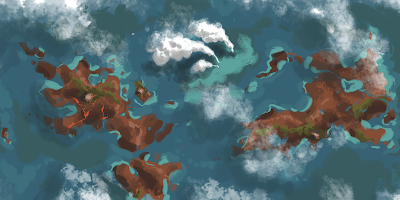Worldbuilding Week 2: Planet M-Franciscae, Land of Supertardigrades
This week, we listened to astrophysicist Jeff Rodger's (South Florida Museum) lecture on quantum mechanics, tying into the Big Bang theory, tying into geological and biological beginnings and development. The lecture was a good reference point for our own project, which is directed to imagining and developing our own exoplanet. The only parameters for this planet is that it abides to our universe's laws of physics, and that it has goldilocks conditions that permit carbon-based life forms. Written below are my notes from the presentation; below this are my specifications for my original exoplanet.
Notes from Jeff Rodger’s presentation, for use on personal project:
- Tidal flexing - europa, jupiter’s moon; gravity stretches/contracts on this and could potentially create goldilocks conditions? Has a lot to do with volcanoes. Find out about the pizza planet Rodgers mentioned for a notable example
- Tilt of axis determines seasons
- dents/cold spots in thermal imaging of the universe has furthered the multiverse theory
- Inflation theory and the progression of the Big Bang
- Planck measurements, basis for quantum mechanics/physics; understood more than regular physics
- Effect of multiple moons and gravity
- Changing atmospheric composition over geological history
- Building blocks for organic molecules, and of DNA and RNA
Notes to self prior to the presentation:
Thinking back to preexisting realms discussed by popular movies… GOTG, Arrival, Avatar, Valkyrie
Consider actual forms - scrappers from various places, trapped on planet? Original/native forms, not accustomed to travel beyond planet?
 |
| Planet skin for M-Franciscae |
Planet name: M-Franciscae, after Mopsechiniscus franciscae, a particularly resilient tardigrade species native to Earth’s Antarctica
M-Franciscae is an exoplanet on which extremophiles have been around long enough to be able to diversify. It deviates from earth’s path by having providing enough time for primitive life to develop intelligence. Planetary characteristics:
- Significant tidal flexing occurred early on in the planet’s formation, leading to plentiful volcanic formation.
- The environment is dominated by volcanic activity and hydrothermal vents. Oceans cover much of the planet, the appearance, biome, and conditions of which echo the Proterozoic and Paleozoic geological Earth eras.
- Low oxygen levels are characteristic to the atmospheric composition of this planet; CO2 dominates it.
- M-Franciscae has two moons at opposite axis ends. As a result, there is more tidal activity on planet, more oscillation to allow some planet cooling, as well as transfer of heat to the poles.
Life and Evolution: eukaryotes, tube worms, scaly-foot gastropods, mollusks, bivalves, tardigrades (most diversification here...into intelligent supertardigrades)

Comments
Post a Comment